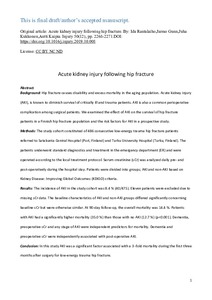Acute kidney injury following hip fracture
Gunn Jarmo; Kukkonen Juha; Rantalaiho Ida; Kaipia Antti
https://urn.fi/URN:NBN:fi-fe2021042824646
Tiivistelmä
BACKGROUND:
Hip fracture causes disability and excess
mortality in the aging population. Acute kidney injury (AKI), is known
to diminish survival of critically ill and trauma patients. AKI is also a
common perioperative complication among surgical patients. We examined
the effect of AKI on the survival of hip fracture patients in a Finnish
hip fracture population and the risk factors for AKI in a prospective
study.
METHODS:
The study cohort constituted of 486
consecutive low-energy trauma hip fracture patients referred to
Satakunta Central Hospital (Pori, Finland) and Turku University Hospital
(Turku, Finland). The patients underwent standard diagnostics and
treatment in the emergency department (ER) and were operated according
to the local treatment protocol. Serum creatinine (sCr) was analyzed
daily pre- and post-operatively during the hospital stay. Patients were
divided into groups; AKI and non-AKI based on Kidney Disease: Improving
Global Outcomes (KDIGO) criteria.
RESULTS:
The incidence
of AKI in the study cohort was 8.4% (40/475). Eleven patients were
excluded due to missing sCr data. The baseline characteristics of AKI
and non-AKI groups differed significantly concerning baseline sCr but
were otherwise similar. At 90-day follow-up, the overall mortality was
14.4%. Patients with AKI had a significantly higher mortality (35.0%)
than those with no AKI (12.7%) (p < 0.001). Dementia, preoperative
sCr and any stage of AKI were independent predictors for mortality.
Dementia and preoperative sCr were independently associated with
post-operative AKI.
CONCLUSION:
In this study AKI was a
significant factor associated with a 3 -fold mortality during the first
three months after surgery for low-energy trauma hip fracture.
Kokoelmat
- Rinnakkaistallenteet [19250]
